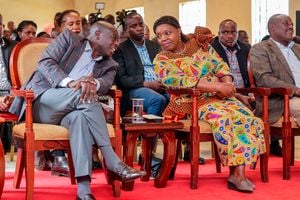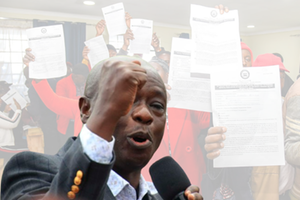Why post-election violence is unheard of on Lamu Island

A trader walks with his donkeys on Lamu Island. The Lamu Old Town has always been always peaceful after elections
In many towns in Kenya, it is a common phenomenon for citizens to demonstrate and show their anger by burning tyres, fighting and even killing, especially after presidential election results are announced.
Business people close their shops in places like Kisumu, Homa Bay, Migori, Nairobi, Mombasa, Nakuru, Naivasha and others for fear of losing their properties in post-election violence.
In Lamu Old Town, things are different.
The town has always been always peaceful after elections, right from the political struggles and violence of the 1990s Saba Saba movement to the 2007/2008 post-election violence that left over 1,000 people dead and property worth millions destroyed.
During the 2017 post-election protests and the destruction of property, Lamu remained peaceful – no incident of violence or property loss was recorded.
Even Deputy President William Samoei Ruto was declared President-elect after the August 9 elections, prompting residents of some towns to express their anger and frustration by burning tyres and closing of shops, in Lamu it was business as usual.
Nation.Africa sought to unearth how communities living in Lamu Old Town have managed to live peacefully every election cycle despite the electoral disputes that follow every presidential poll in Kenya.
Mohamed Mbwana, a historian and Lamu elder, attributes the harmonious and friendly behaviour of Lamu people to history.
Mr Mbwana insists that Lamu Old Town has a history of communities coexisting peacefully.
The port city of Lamu was founded in the 12th century. It is an important trade centre in East Africa.
Lamu Old Town is considered the oldest and best-preserved Swahili settlement in East Africa.
Unlike other Swahili settlements that were abandoned along the East African coast, Lamu has been inhabited continuously for over 700 years.
The town has about 30,000 people.
Mr Mbwana noted that in the old days people from various countries and regions migrated to the island of Lamu.
Traders and sailors from the Arabian Peninsula, China, India and southeast Asia travelled across the Indian Ocean to the East African coast to reach the island.
The mix of sailors and traders with native people created distinguishable social classes and a diverse social structure.
Mr Mbwana reiterated that the abundance of a diversity of people trading on the island impacted its culture.
“People from far lands, islands and from various cultures used to interact with locals here and ended up forming friendships. This gave the local people the opportunity to adopt different customs as their own,” Mr Mbwana said.
“Such adopted welcoming behaviours have continued up to date. We don’t see the reason for forming grudges with others or involving ourselves in any form of violence. We value peace more than anything else.”
Mahmoud Mau, a renowned Muslim scholar and cleric in Lamu, noted that Lamu people’s tendency to embrace peaceful coexistence can also be linked to religion.
Lamu is predominantly Muslim.
Mr Mau stresses that Lamu Old Town is recognised for its important commercial role and attraction of scholars and teachers, which has made the historical town a centre of Islamic education and Swahili culture.
Lamu’s prominent role in spreading Islam has generally influenced the current generation to fully embrace the religion, observe peace, and respect one another.
Mr Mau stresses that the shared religion, traditions and culture is key to holding Lamu society together.
“I can attribute the calmness and peaceful behaviour of Lamu people to two things – religion and upbringing. Lamu is the centre of Islam,” he said.
“We are raised right from an early age that we ought to love and respect one another and observe peace. This has born fruits. That’s why almost all parts of the country might witness post-election violence but not a single incident has been recorded in Lamu.”
Mohamed Abdulkadir, a cleric and elder, cites the geographical location of Lamu Old Town as one of the factors contributing to the prevailing peace in the area.
Mr Abdulkadir refers to Lamu as ‘an Island of peace’.
“Geographically, Lamu is an island. This makes it easy for someone with bad intentions to be acted upon and arrested by security agents,” he said.
“It’s not easy for one to cross over to the mainland areas before you’re captured. And that’s why people, including the youth, can’t even try to partake in violence. This has greatly helped to make Lamu an island of peace.”
Amina Shekuwe, a community leader, said Lamu voters have not been interested in national politics, especially the outcome of presidential elections.
Residents care more about the governor, senator, MP, and MCA positions.
“This has helped us maintain peace here. Normally, violence erupts especially when presidential results are announced. The Lamu people do not support particular candidates when it comes to presidential elections. We accept whoever is declared the President-elect,” said Ms Shekuwe.
Mohamed Mwenje, the National Museums of Kenya (NMK) curator in charge of Lamu museums and World Heritage site, cites demographics as a key reason the Lamu community maintains peace, love and unity.
“Lamu people have always lived and perceived themselves as a homogenous society. The population here seems to live like a single community with the same religion, tradition, and cultural practices,” he said.
“This doesn’t allow room for grudges or violence, because you might end up slashing your cousin’s head or uncle’s arm. What these people know is nothing but peace.”





